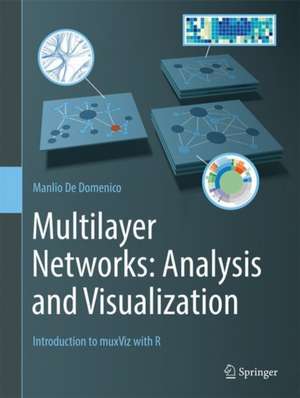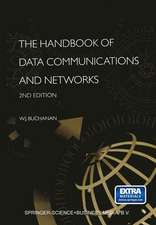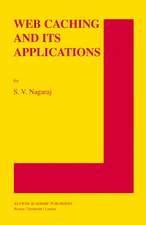Multilayer Networks: Analysis and Visualization: Introduction to muxViz with R
Autor Manlio De Domenicoen Limba Engleză Hardback – apr 2022
In addition to researchers in the field of network science, as well as practitioners interested in network visualization and analysis, this book will appeal to researchers without strong technical or computer science background who want to learn how to use muxViz software, such as researchers from humanities, social science and biology: audiences which are targeted by case studies included in the book. Other interdisciplinary audiences include computer science, physics, neuroscience, genetics, urban transport and engineering, digital humanities, social and computational social science.
Readers will learn how to use, in a very practical way (i.e., without focusing on theoretical aspects), the algorithms developed by the community and implemented in the free and open-source software muxViz. The data used in the book is available on a dedicated (open and free) site.
| Toate formatele și edițiile | Preț | Express |
|---|---|---|
| Paperback (1) | 983.85 lei 6-8 săpt. | |
| Springer International Publishing – 2 apr 2023 | 983.85 lei 6-8 săpt. | |
| Hardback (1) | 886.75 lei 38-44 zile | |
| Springer International Publishing – apr 2022 | 886.75 lei 38-44 zile |
Preț: 886.75 lei
Preț vechi: 1108.43 lei
-20% Nou
Puncte Express: 1330
Preț estimativ în valută:
169.70€ • 184.27$ • 142.55£
169.70€ • 184.27$ • 142.55£
Carte tipărită la comandă
Livrare economică 18-24 aprilie
Preluare comenzi: 021 569.72.76
Specificații
ISBN-13: 9783030757175
ISBN-10: 303075717X
Pagini: 105
Ilustrații: XXXI, 105 p.
Dimensiuni: 210 x 279 mm
Greutate: 0.56 kg
Ediția:1st ed. 2022
Editura: Springer International Publishing
Colecția Springer
Locul publicării:Cham, Switzerland
ISBN-10: 303075717X
Pagini: 105
Ilustrații: XXXI, 105 p.
Dimensiuni: 210 x 279 mm
Greutate: 0.56 kg
Ediția:1st ed. 2022
Editura: Springer International Publishing
Colecția Springer
Locul publicării:Cham, Switzerland
Cuprins
Part 1. Multilayer Network Science: Analysis and Visualization.- 1. Introduction.- 2. Multilayer Networks: Overview.- 3. Multilayer Analysis: Fundamentals and Micro-scale.- 4. Multilayer Versatility and Triads.- 5. Multilayer Organization: Meso-scale.- 6. Other Multilayer Analyses based on Dynamical Processes.- 7. Visualizing Multilayer Networks and Data.- Part 2. Appendices.- A. Installing and Using muxViz.
Notă biografică
Manlio De Domenico is a physicist and complexity scientists, currently a Senior Researcher at FBK (Italy) where he is also the director of the Complex Multilayer Networks Lab. He is the national coordinator of the Italian Chapter of the Complex Systems Society, Adjoint Professor of Network Science at University of Trento and Visiting Professor at Universitat Rovira i Virgili.
He is known for multilayer models intertwining human mobility, infectious disease spreading and other types of human dynamics such as awareness, bounded rationality, social segregation and integration. His research focuses on collective phenomena emerging from natural and artificial interdependent systems, with contributions to multiscale modeling and analysis of multilayer networks, their structure, dynamics, information capacity and resilience to shocks, finding applications in systems biology, systems medicine, computational social sciences, computational epidemiology and data-driven policy making.
For his works on the complexity of systems of systems and interdisciplinary applications he received the Young Scientist Award for Socio- and Econophysics from the German Physical Society (2020), the IUPAP Young Scientist Award on Statistical Physics from the IUPAP-C3 (2019), the USERN Prize in Formal Sciences from USERN (2017) and the Junior Scientific Award from the Complex Systems Society (2016).
For his works on the complexity of systems of systems and interdisciplinary applications he received the Young Scientist Award for Socio- and Econophysics from the German Physical Society (2020), the IUPAP Young Scientist Award on Statistical Physics from the IUPAP-C3 (2019), the USERN Prize in Formal Sciences from USERN (2017) and the Junior Scientific Award from the Complex Systems Society (2016).
Textul de pe ultima copertă
The adoption of multilayer analysis techniques is rapidly expanding across all areas of knowledge, from social sciences (the first facing the complexity of such structures, decades ago) to computer science, from biology to engineering. However, until now, no book has dealt exclusively with the analysis and visualization of multilayer networks. Multilayer Networks: Analysis and Visualization provides a guided introduction to one of the most complete computational frameworks, named muxViz, with introductory information about the underlying theoretical aspects and a focus on the analytical side. Dozens of analytical scripts and examples to use the muxViz library in practice, by means of the Graphical User Interface or by means of the R scripting language, are provided.
In addition to researchers in the field of network science, as well as practitioners interested in network visualization and analysis, this book will appeal to researchers without strong technical or computer science background who want to learn how to use muxViz software, such as researchers from humanities, social science and biology: audiences which are targeted by case studies included in the book. Other interdisciplinary audiences include computer science, physics, neuroscience, genetics, urban transport and engineering, digital humanities, social and computational social science.
Readers will learn how to use, in a very practical way (i.e., without focusing on theoretical aspects), the algorithms developed by the community and implemented in the free and open-source software muxViz. The data used in the book is available on a dedicated (open and free) site.
Caracteristici
Provides practical recipes to use muxViz for specific purposes, bypassing theoretical obstacles Includes dozens of examples whose R code is provided and directly linked from inside the text Comes with, and builds on, a significant extension of the muxViz platform that can be used without needing a GUI




























